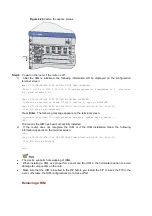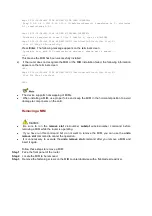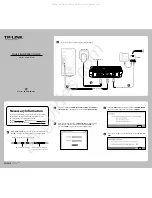
Table 4-4
Power supply interface and PGND terminal of the device
Item
Description
AC power socket (for the AC-powered router)
Provides 100 VAC to 240 VAC
DC power input terminals (for the DC-powered
router)
Provides –60 VDC to –48 VDC
PGND terminal
Connected to the ground through a PGND cable. For
the connection of the grounding terminal, refer to
“
PGND Cable Connection
” on page 4-7.
Connecting the AC Power Cord
AC power supply
Rated voltage range: 100 VAC to 240 VAC, 50 Hz to 60 Hz.
AC power socket
Figure 4-42
illustrates an AC power module in the chassis.
Figure 4-42
AC power module in a chassis
(1) Captive screw
(2) Bail latch holder
(3) AC power socket
(4) Power switch
(5) Power LED
(6) Power module handle
Use a three-terminal, single-phase power connector with a grounding contact.
Ground the power supply reliably. Normally, the grounding contact of the power supply system
in a building was buried during construction and cabling.
Before connecting the AC power cord, make sure that the power supply of the building is well
grounded.
Connection procedure
Follow these steps to connect the AC power cord:
Step1
Make sure that the PGND terminal is securely connected to the ground.
Step2
Move the AC power switch on the power modules to the OFF position.
Step3
Move the bail latch to the left.
Step4
Connect one end of the supplied AC power cord to the power socket on the router, and the
other end to an AC power outlet.
Step5
Move the bail latch to the right to hold the power cord in position.
Step6
Move the power switches on all power modules to the ON position.
Step7
Check the status of the PWR LED on the front panel of the router. For the status of the power
LED, see
Table 4-5
.
















































